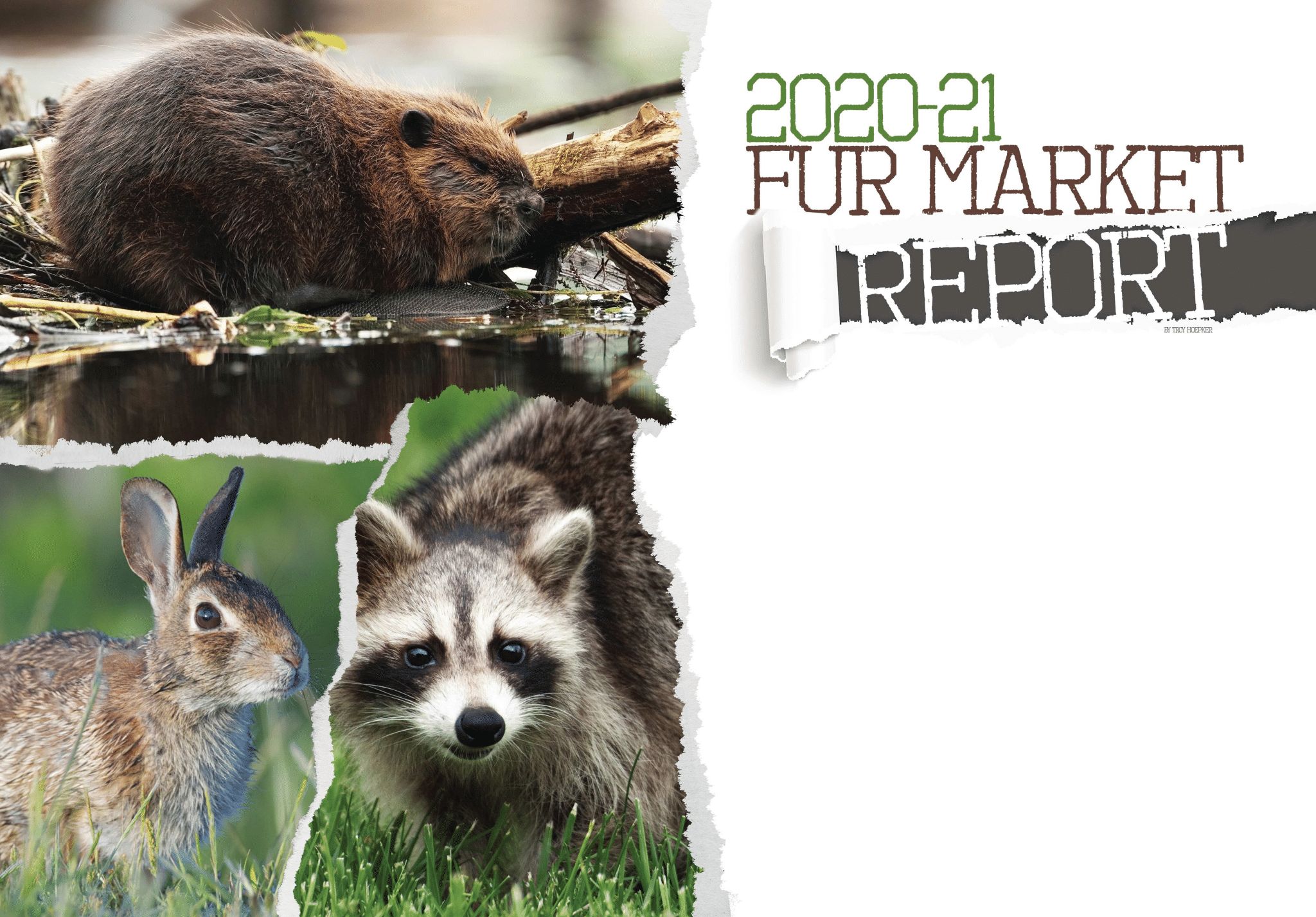2020-21 Fur Market Report

2020-21 Fur Market Report
Writing the magazine’s fur market outlook report in recent years, I recall thinking to myself, “Surely next year’s report will be more positive. Surely next year we’ll begin to climb out of the doldrums we are stuck in.” The next year would come and I’d report on the same doom and gloom surrounding the market. “Surely next year will be better and I’ll have happier news to report,” I’d optimistically tell myself. It’s been that way since 2013, steadily declining every year influenced by everything imaginable that could shake a fur industry to its core. And just when you really truly think you’ve scraped the very bottom, 2020 hits and proves that the “bottom” can indeed get much, much deeper.
Change comes to the Fur Market
As 2019 transitioned into 2020 no one dreamed that we would see auctions cancelled, international travel halted and clothing store closures all over the world. The worst-case scenario that we thought we already had somehow entered a new realm of disaster. The Coronavirus would change every aspect of our lives for the negative and its impact on the fur market has been devastating. Late last year North American Fur Auctions (NAFA), the oldest fur auction in North America, was forced to close its doors even before COVID was a household word. NAFA traced their roots back almost 350 years to the Hudson’s Bay Company. They were the leader of wild fur sales in the world.
Luckily the one big player left in the auction house business, Fur Harvesters Auction (FHA) based in North Bay, Ontario have announced that they are financially sound and willing and able to pick up the extra volume of fur in NAFA’s absence. Fur Harvesters Auction will expand their routes and schedules and have acquired some of NAFA’s assets as well as hired some of their former employees. With over 15,000 North American trappers that worked exclusively with NAFA now looking for a new outlet to offload their skins, Fur Harvesters Auction will hope to capture a majority of that business.
In the early part of 2020, (post NAFA) Fur Harvesters Auction set dates for major fur auctions to be held in March and June. Unfortunately COVID hit and those dates had to be cancelled. With the only major auction house left unable to have auctions, the sale of fur went almost non-existent.
Sell Local
For the local trapper however, there is an outlet to sell your skins and be paid on the spot. Local country buyers still exist and larger players in the market still run regular routes buying fur. One of those large players is Groenewold Fur & Wool Co. Maybe you know them well? Based out of Forreston, Illinois, Groenewold has traveled these parts for years and you may have been a regular customer of theirs already. Now they look to expand. While not an auction house like Fur Harvester’s Auction, Groenewold is still a major fur buyer in the industry.
I visited with Groenewold’s Bryce Kubly, a partner in the company, about what we can expect.
“We will still be running our routes and those route schedules will be posted on our website (www.gfwco.com).” Bryce said. “It’s hard to price early in a year like this but we are committed to be as aggressive as we can be in buying your furs.” Kubly added, “Coyote are definitely going to be the strongest.”
Advice from the Pro
The best advice Kubly had was to trap when pelts are prime. “Stay away from blue pelts. Trappers might wait till prime. Early coyote and other skins are not in demand so wait until your pelts can bring the most value.” Kubly advised.
Companies like Groenewold are the lifeblood of our industry. Without valued buyers we wouldn’t be anywhere. That truck that you meet on its route or the fur house in your hometown or neighboring town are the windows to the world for your fur. From those humble beginnings, your fur moves internationally. We all want the best possible price for our furs but save some back for the local buyer or sell your whole load to them if you’re pleased with the price. Too many country buyers have had to close their doors in recent years. Remember to support what we have left. It’s nice to have them.
Effects of Covid on the Market
There are still millions of furs in cold storage unsold around the world. That backlog creates the foundation of a sluggish market to begin with. Economic woes caused by today’s Coronavirus pile on a fur market that’s already lying flat on its back. Moving products is much harder than it once was. Importing and exporting problems associated with Coronavirus, as well as worker shortages in garment making facilities slow the process of fur being made into garments throughout the world. Workers in factories have to socially distance, things need sanitized and cleaned much more thoroughly and workers are occasionally quarantined. All of this adds to the expense of making those garments made of wild fur. That expense is passed on to the consumer.
As far as the consumer goes, fur is still fashionable, but if stores are closed, fur coats aren’t selling. When people’s jobs are in jeopardy or they are laid off because of Coronavirus they aren’t spending extra money on fur coats. The large garment manufacturers of China, South Korea and India among others won’t buy more raw fur if they can’t move what they already have. Just as retailers won’t buy more garments made by those manufacturers if they can’t sell what they have on their store racks. Meanwhile skins sit backing up in cold storage waiting their turn to be purchased, moved and turned into goods.
A cold winter in China and Russia can always help the market some. Those areas traditionally buy more fur garments. But if cash strapped families can’t afford new clothing, they’ll likely get by with what they already have hanging in the closet. If consumers can’t get into the stores to handle, feel and try on for size those garments they are unlikely to buy them online.
Reluctance in the Market
Speculators that have already purchased heavily in past years are reluctant now to speculate much further with such uncertainty of the market. Their cash stays in their pocket until things move and free up a little. Other detrimental factors such as tariffs, political relations with China, and continuing turmoil in Russia add to the chaos of the market.
You can see how movement isn’t happening all the way through the chain from the animal in the trap to the final step of the consumer buying a coat off the rack of their local retailer. So not only have speculators, furriers and fur buyers of all kinds slowed their buying to a crawl, but this year most of them haven’t even had an avenue to purchase fur at all with auctions being cancelled from COVID. There’s worry that furriers, tanneries and buyers all going bankrupt and closing their doors for good will leave us short handed when fur someday begins to move again.
The Mink Farms
Another player in the economic field of fur market volatility is the current ranched mink situation. Huge mink farms have the ability to create large animals all with a uniform color. Garment makers prefer ranch mink and actively buy those sections over wild fur.
Now, with the collapse of the market, many ranch mink farms have had to “pelt out” selling all inventory. With ranched mink operations putting thousands of furs into an already backlogged supply, it doesn’t help the supply/demand situation that affects the market.
To make matters worse large mink farms in Denmark and the Netherlands recently had outbreaks of the Coronavirus in mink herds. Infections of the virus spread rapidly in pen raised mink and entire operations of thousands of mink had to be gassed to prevent further spread of the virus. There is speculation that the downturn in ranch mink farms could help wild mink prices and other shorthaired furs when the market does eventually begin to turn around. The scare of mink ranching collapsing completely however could sink garment-making manufacturers in Turkey and Greece and other European nations for good. All of this uncertainty makes for worrisome times and there may be a new look to the fur industry when we come out on the other side of this.
First Auction of the Year
On August 30-31 of this year, Fur Harvesters Auction Inc. were finally able to hold an auction. Only Canadian brokers were able to attended because of Canada’s travel bans but the phones attached to the ears of many brokers indicated that foreign interests indeed had a presence at the auction. All unsold goods after the two day auction were transferred to an online auction that ran from September 4 to September 11th. Finally thousands of skins sold after the market had been in a hold period for so long. Using the results of sales from this auction along with other market indicators I’ll give you the best guess at what you can expect for your Iowa fur species this season.
Beaver will remain slow again this year from a fur perspective. About the only market for Iowa beaver fur may be in hatter market prices. Expect $5-8 for most skins and $8-12 for large, fully prime Iowa specimens. The money isn’t in the fur for beaver this year as much as it is in the castoreum. Castor glands of the beaver are being sold at high prices per pound for top grade stuff. The reason is because of reduced beaver trapping the last few years in this down market. It’s left castoreum in short supply. Beaver pelts at the FHA Sept. auction averaged $12.95 but only 25% of the 80,346 skins were actually sold so that likely means the 25% were the best of the bunch at that price.
Animal Markets
Mink
If you trap wild mink, you’ll likely be doing it for the fun of it. You’re at the mercy of a world flooded with ranch mink right now. Take what you can get and if it’s $3, probably be very happy with that. If you get $5 for a fully put up male with feet attached, walk away delighted is my guess. Mink at the FHA auction went mainly unsold.
Muskrats
Expect muskrat here to move in the $1.50-$3 range same as last year. The huge supply of ranch mink in the system will continue to hold this animal down, likely for the next couple of years. Rats always seem to be sellable and they are a good nuisance critter to target. FHA auction sales for muskrat sold at 56% for a $2.49 average on 70,000 skins. Better movement than I anticipated!
Otter
My hope for otter prices were that they could be as high as $20 but I have my doubts after seeing only 25% of total otter offerings at FHA’s auction sell for a $15.55 average. I knew that there are a lot of otter out there in cold storage and that showed evidently true with only select goods likely moving.
Red Fox
The red fox market is dismal. Very little demand, even for good specimens. Expect $10-$15 for prime, large pelts with thick underfur and $6-$10 for anything that is considered less than that or damaged in any way. Red fox went mostly unsold at auction.
Raccoon
Iowa’s largest volume seller and frankly, easiest catch, the raccoon will see similar prices to last year if not slightly lower. Most buyers will still buy knowing the raccoon is the bread and butter of most trapper’s lines, but try not to mess around with blue coon. Also expect buyers to refuse carcass coon or “in the grease” coon. Trap when the animal is prime and you can still expect to see an awful lot of $5 coon out there. Expect to see $5-$10 for XXL skins with occasional XXXL fully prime skins fetching the $12-$15 amount. Recent FHA auction lots went mainly unsold showing a hesitance still lingering in the market.
Skunk
Skunk might retain a $1-$3 value while badger might gain you a few extra dollars beyond that. There’s more value in both animals by skinning and tanning the hide and selling it as a novelty item.
Bobcat
With only 15% of lynx cat sold at auction, predicting the bobcat market price is a little harder, other than knowing that demand is not high for our flatter Iowa cats. Expect prices near last year’s at $25-$35 for average, non-damaged skins with big males possessing wide, white bellies that are heavily spotted fetching upwards of $50 or more. Those might be the skins to send to auction if possible.
Coyote
I saved the best for last and the one bright spot in the market report, the coyote! The trim trade remains strong and FHA auction prices were great for coyotes of most sections. Bidding was very active from at least a dozen different buyers during the auction indicating a strong demand still exists. Semi-heavy, darker coyotes like the ones Iowans see when fully prime with distinct guard hairs, dense underfur and no damage will bring $30-$45 range same as last year. Add any damage at all or make it a slightly less than prime pelt with weaker, thinner flanks and underbelly and drop that prices to $20-$25 range. A coyote with bullet holes, snare marks or weak belly and sides may still fetch $10-$15. Even a damaged coyote with a good back will earn a $5 bill.
There are some out there that expect the coyote bubble to burst this year or soon. I can see their reasoning for that this year. The market is so uncertain that it won’t take much to drop demand on coyote as well so my advise is catch or hunt them when prime, skin them and finish the hide to the best of your ability and don’t hang on to them too long. Sell when you can.
by Troy Hoepker
December 2020
If you are interested here is the 2021-22 Fur Market Report


